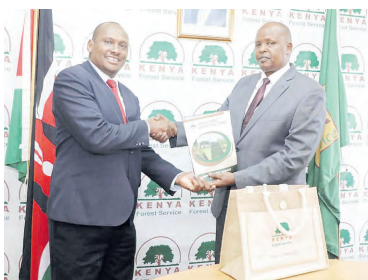

The multiple threats facing Lake Naivasha Basin are set to be reversed once a multibillion-shilling project is rolled out.
The Lake Naivasha Basin Ecosystem-Based Management Project seeks to restore forest ecosystems and reduce land degradation in the Lake Naivasha Basin.
The project will be implemented over four years, with a budget of $1,785,422 (Sh231 million), in addition to an estimated co-financing contribution of $49,341,919 (Sh6.3 billion).
It will operate under a financial agreement to be signed between World Wide Fund, the GEF Project Agency and the Ministry of Finance.
The National Environment Trust Fund will act as the lead executing agency for the project.
The day-to-day management of the project will be undertaken by a project management unit.
The unit will be responsible for the coordination of work between partners in the project. It will also be responsible for the reporting, monitoring and evaluation functions.
On March 26, NET Fund CEO Samson Toniok met with chief conservator of forests Alex Lemarkoko to discuss the project’s implementation.
Toniok said NET Fund, as the agency charged with mobilising resources for environmental protection, will continue engaging development partners.
“We will continue mobilising resources for environmental protection,” Toniok said.
He said the three-year project will help reverse threats facing the basin. The Lake Naivasha Basin is challenged by land degradation, water pollution and loss of biodiversity, resulting in a reduction in provision of ecosystem services.
This is caused by a number of threats, in particular poor agricultural practices by small-scale farmers in the upper catchment; overgrazing and illegal logging in the lower, middle and upper catchment and pollution of water bodies from farmlands, settlements and industries.
Other challenges include over-abstraction of water resources; urbanisation, agricultural expansion, infrastructure development and other types of development associated with land use change and impacts of climate change.
The project objective is to restore forest ecosystems and reduce land for increased protection of Lake Naivasha’s water resources, biodiversity and associated ecosystem services to support the local and national economy.
The challenges facing the basin can be addressed if community, sectors and counties are supported to undertake joint responsibility for the management of the basin through participatory planning and multi-stakeholder engagement forums.
The impacts from smallholder agriculture in the upper catchment on the lake can be reduced through introduction of improved farmer techniques, access to finance and markets for sustainable production and the institutionalisation and implementation of landscape restoration and management measures.
Lemarkoko said the project is crucial for the forest sector as it will not only conserve the Aberdare catchment but the tree growing initiatives under the project will also contribute to the government’s 15 billion tree campaigns.
“The project will not only strengthen the capacity of KFS field officers but will also boost tree seedlings capacity,” he said.
The Lake Naivasha Basin covers 3,400 square kilometres. Lake Naivasha is one of the two freshwater lakes in the Rift Valley.











